Performance of Cement Composites with Partial Replacement with Organic Aggregate from Waste Coconut Shell
Abstract
:1. Introduction
2. Results and Discussion
2.1. Physical and Mechanical Properties of Coconut Shell
2.2. Evaluation of Compatibility of Deformations of Cement–Sand Matrix and Coconut Aggregate
2.3. Results of Strength Tests of Samples
3. Materials and Methods
3.1. Materials
- Portland cement CEM I 42.5N produced by “Peterburgcement” (Slantsy, Leningrad region, Russia) with the following characteristics:
- −
- Compressive strength at the age of 2 days is not less than 10 MPa;
- −
- Compressive strength at the age of 28 days is 42.5–62.5 MPa;
- −
- Setting begins no earlier than 60 min;
- −
- Specific surface area is 350 m²/kg.
- 2.
- Quartz polyfractional sand for cement testing according to EN 196-1 [37].
- 3.
- Endocarp of mature coconut shell from Thailand, which is a waste product of coconut shavings production. Coconut shell contains amorphous and crystalline carbonaceous materials, which contain 21.8% fixed carbon, 70.8% volatile matter, 5.6% moisture and 1.8% ash [38]. The chemical composition of coconut ash according to [39] is given in Table 2.
3.2. Methods of Studying the Endocarp of Coconut Shell
3.3. Composition and Production of Samples from Cement Mortar with Partial Replacement of Sand with Coconut Shell Aggregate
3.4. Methodology for Testing Samples
4. Conclusions
- The properties of coconut shell endocarp, such as average and true density, water absorption, porosity, and volumetric expansion upon swelling in water, were experimentally established.
- It was established that the volume expansion of the coconut shell endocarp during swelling in water is at least 10 times greater than the volume deformation of the swelling of the cement matrix, which is no more than 1%.
- When using the fine coconut aggregate and replacing standard sand from 2 to 15%, the accumulated expansion is observed only in the first 4–5 test cycles, and then followed by accumulated shrinkage. The initial accumulated expansion increases with the percentage of replacement of natural sand with coconut aggregate. Since the control mix shows only shrinkage, the expansion of the samples is due to swelling of the coconut aggregate. The final value of the accumulated shrinkage of the studied samples, despite the initial expansion, is higher than that of the control ones, so it can be concluded that the organic aggregate contributes to the shrinkage deformation as a result of its own gradual shrinkage from cycle to cycle.
- A gradual decrease in the average mass of the samples from cycle to cycle was established, caused by the evaporation of water during drying. Consequently, with each subsequent cycle, the volume of space filled with absorbed water increases, which is a consequence of swelling of the coconut shell endocarp and microcracking in the cement matrix.
- There is a direct relationship between expansion and the amount of water absorbed in cycles for the coarse coconut aggregate. Swelling of the aggregate leads to the formation of microcracks in the matrix and the opening of closed pores, which contributes to the growth of further water absorption and swelling, this in turn leads to an increase in crack formation. Such an interdependent process ensures the rapid destruction of the cement matrix.
- The obtained dependences of accumulated moisture deformations of expansion and shrinkage on the amount of water absorbed and lost in cycles show that during the period of accumulated shrinkage development, the loss of mass of the samples increases. After the samples reach the accumulated shrinkage of approximately 0.4 mm/m, the amount of absorbed (evaporated) water decreases from cycle to cycle. This indicates the occurrence of two oppositely directed processes, one of which, for example, is associated with a decrease in the volume of the samples as a result of general shrinkage and a corresponding decrease in the internal empty volume filled with water, and the other with an increase in the internal empty volume as a result of contraction.
- Partial replacement of sand with coconut aggregate reduces the strength of the cement mortar, and increases with a larger replacement percentage. The use of a coarse coconut aggregate (5–20 mm) when replacing 50% of the sand led to the destruction of 28-day samples after several wetting–drying cycles. When using a powder fraction, no external signs of destruction of the cement samples were observed.
Author Contributions
Funding
Data Availability Statement
Conflicts of Interest
References
- Liu, H.; Li, Q.; Ni, S.; Wang, L.; Yue, G.; Guo, Y. Effect of nano-silica dispersed at different temperatures on the properties of cement-based materials. J. Build. Eng. 2022, 46, 103750. [Google Scholar] [CrossRef]
- Bai, G.; Zhu, C.; Liu, C.; Liu, B. An evaluation of the recycled aggregate characteristics and the recycled aggregate concrete mechanical properties. Constr. Build. Mater. 2020, 240, 117978. [Google Scholar] [CrossRef]
- Tam, V.W.Y.; Butera, A.; Le, K.N.; Li, W. Utilising CO2 technologies for recycled aggregate concrete: A critical review. Constr. Build. Mater. 2020, 250, 118903. [Google Scholar] [CrossRef]
- Kumar, K.; Dixit, S.; Arora, R.; Vatin, N.I.; Singh, J.; Soloveva, O.V.; Ilyashenko, S.B.; John, V.; Buddhi, D. Comparative Analysis of Waste Materials for Their Potential Utilization in Green Concrete Applications. Materials 2022, 15, 4180. [Google Scholar] [CrossRef]
- Kolesnikova, O.; Syrlybekkyzy, S.; Fediuk, R.; Yerzhanov, A.; Nadirov, R.; Utelbayeva, A.; Agabekova, A.; Latypova, M.; Chepelyan, L.; Volokitina, I.; et al. Thermodynamic Simulation of Environmental and Population Protection by Utilization of Technogenic Tailings of Enrichment. Materials 2022, 15, 6980. [Google Scholar] [CrossRef]
- Chin, W.Q.; Lee, Y.H.; Amran, M.; Fediuk, R.; Vatin, N.; Kueh, A.B.H.; Lee, Y.Y. A Sustainable Reuse of Agro-Industrial Wastes into Green Cement Bricks. Materials 2022, 15, 1713. [Google Scholar] [CrossRef]
- Barabanshchikov, Y.; Usanova, K. Influence of Silica Fume on High-Calcium Fly Ash Expansion during Hydration. Materials 2022, 15, 3544. [Google Scholar] [CrossRef]
- Barabanshchikov, Y.; Usanova, K.; Akimov, S.; Bílý, P. Low heat concrete with ground granulated blast furnace slag. IOP Conf. Ser. Mater. Sci. Eng. 2020, 896, 012098. [Google Scholar] [CrossRef]
- Khanzada, F.A.; Nazir, K.; Ishtiaq, M.; Javed, M.F.; Kashif-Ur-rehman, S.; Aslam, F.; Musarat, M.A.; Usanova, K.I. Concrete by Preplaced Aggregate Method Using Silica Fume and Polypropylene Fibres. Materials 2022, 15, 1997. [Google Scholar] [CrossRef]
- Ibraheem, M.; Butt, F.; Waqas, R.M.; Hussain, K.; Tufail, R.F.; Ahmad, N.; Usanova, K.; Musarat, M.A. Mechanical and Microstructural Characterization of Quarry Rock Dust Incorporated Steel Fiber Reinforced Geopolymer Concrete and Residual Properties after Exposure to Elevated Temperatures. Materials 2021, 14, 6890. [Google Scholar] [CrossRef]
- Arandara, K.P.; Paranavithana, G.N.; Priyadarshana, S.T.; Pitawala, H.M.T.G.A.; Dissanayake, R. Evaluation of coconut shell biochar on recycled aggregate concrete through petrographic studies. Constr. Build. Mater. 2024, 428, 136342. [Google Scholar]
- Ahmad, J.; Zhou, Z.; Martínez-García, R.; Vatin, N.I.; De-Prado-gil, J.; El-Shorbagy, M.A. Waste Foundry Sand in Concrete Production Instead of Natural River Sand: A Review. Materials 2022, 15, 2365. [Google Scholar] [CrossRef] [PubMed]
- Karunarathna, S.; Linforth, S.; Kashani, A.; Liu, X.; Ngo, T. Effect of recycled rubber aggregate size on fracture and other mechanical properties of structural concrete. J. Clean. Prod. 2021, 314, 128230. [Google Scholar]
- Durczak, K.; Pyzalski, M.; Sujak, A.; Juszczyk, M.; Sala, D.; Ustinovichius, L. Efficient Management of Asbestos Waste Through Utilization as Mineral Additives in Portland Cement Production. Materials 2024, 17, 5793. [Google Scholar] [CrossRef]
- Palh, A.R.; Mangi, S.A.; Odho, M.A.; Kalhoro, A.A. Experimental Study on Concrete Incorporating Date Seed as Partial Replacement of Coarse Aggregates. Neutron 2021, 20, 113–122. [Google Scholar]
- Sanchaya, M.; Harikaran, M.; Cheran, K.; Varoon, M.; Jayaprakash, P.; Navin, G. Experimental investigation on rice husk ash and coconut shell used in building materials. Mater. Today Proc. 2022, 68, 1697–1702. [Google Scholar]
- Muthusamy, K.; Nordin, N.; Vesuvapateran, G.; Ali, M.; Mohd Annual, N.A.; Harun, H.; Ullap, H. Exploratory Study of Rubber Seed Shell as Partial Coarse Aggregate Replacement in Concrete. Res. J. Appl. Sci. Eng. Technol. 2014, 7, 1199–1202. [Google Scholar]
- Hamada, H.M.; Skariah Thomas, B.; Tayeh, B.; Yahaya, F.M.; Muthusamy, K.; Yang, J. Use of oil palm shell as an aggregate in cement concrete: A review. Constr. Build. Mater. 2020, 265, 120357. [Google Scholar]
- Durczak, K.; Pyzalski, M.; Pilarski, K.; Brylewski, T.; Sujak, A. The Effect of Liquid Slurry-Enhanced Corrosion on the Phase Composition of Selected Portland Cement Pastes. Materials 2021, 14, 1707. [Google Scholar] [CrossRef]
- Athira, G.; Bahurudeen, A. Rheological properties of cement paste blended with sugarcane bagasse ash and rice straw ash. Constr. Build. Mater. 2022, 332, 127377. [Google Scholar]
- Mohamad, N.; Muthusamy, K.; El Gelany Ismail, M.A.K. Cockle Shell as Mixing Ingredient in Concrete: A Review. Construction 2021, 1, 9–20. [Google Scholar]
- Prusty, J.K.; Patro, S.K. Properties of fresh and hardened concrete using agro-waste as partial replacement of coarse aggregate: A review. Constr. Build. Mater. 2015, 82, 101–113. [Google Scholar]
- Gunasekaran, K.; Kumar, P.S.; Lakshmipathy, M. Mechanical and bond properties of coconut shell concrete. Constr. Build. Mater. 2011, 25, 92–98. [Google Scholar]
- Lejano, B.; Elevado, K.J.; Fandiño, M.A.; Ng, E.A.; Nicole Datinguinoo, Z.A.; Oliveros, S.B. Experimental investigation of utilizing coconut shell ash and coconut shell granules as aggregates in coconut coir reinforced concrete. Clean. Eng. Technol. 2024, 21, 100779. [Google Scholar]
- Thilagashanthi, T.; Gunasekaran, K.; Satyanarayanan, K.S. Microstructural pore analysis using SEM and ImageJ on the absorption of treated coconut shell aggregate. J. Clean. Prod. 2021, 324, 129217. [Google Scholar]
- Ranatunga, K.S.; del Rey Castillo, E.; Toma, C.L. Evaluation of the optimal concrete mix design with coconut shell ash as a partial cement replacement. Constr. Build. Mater. 2023, 401, 132978. [Google Scholar]
- Saadullah, S.T.; Haido, J.H.; Al-Kamaki, Y.S.S. Mechanical properties of sustainable green self-compacting concrete incorporating recycled waste PET: A state-of-the-art review. Adv. Concr. Constr. 2023, 16, 35–57. [Google Scholar]
- Tomar, R.; Kishore, K.; Singh Parihar, H.; Gupta, N. A comprehensive study of waste coconut shell aggregate as raw material in concrete. Mater. Today Proc. 2021, 44, 437–443. [Google Scholar]
- Bhoj, S.; Manoj, A.; Bhaskar, S. Usage potential and benefits of processed coconut shells in concrete as coarse aggregates. Mater. Today Proc. 2023, in press. [Google Scholar] [CrossRef]
- Mathew, S.P.; Nadir, Y.; Arif, M.M. Experimental study of thermal properties of concrete with partial replacement of coarse aggregate by coconut shell. Mater. Today Proc. 2020, 27, 415–420. [Google Scholar]
- Stel’makh, S.A.; Beskopylny, A.N.; Shcherban’, E.M.; Mailyan, L.R.; Meskhi, B.; Shilov, A.A.; El’shaeva, D.; Chernil’nik, A.; Kurilova, S. Alteration of Structure and Characteristics of Concrete with Coconut Shell as a Substitution of a Part of Coarse Aggregate. Materials 2023, 16, 4422. [Google Scholar] [CrossRef] [PubMed]
- Arora, R.; Kumar, K.; Dixit, S.; Tipu, R.K.; Kaul, P.; Chauhan, S.; Raju, Y.K.; Nijhawan, G.; Haindavi, P. Parametric investigation of coconut shells as partial replacement of coarse aggregates in sustainable concrete. E3S Web Conf. 2023, 430, 01180. [Google Scholar] [CrossRef]
- Serda, M.; Becker, F.G.; Cleary, M.; Team, R.M.; Holtermann, H.; The, D.; Agenda, N.; Science, P.; Sk, S.K.; Hinnebusch, R.; et al. Behaviour of Coconut Shell Aggregate (CSA) Concrete at Elevated Temperature. Int. J. Sci. Res. Dev. 2020, 8, 390–393. [Google Scholar]
- Kumbhar, M.V.P.; Pawar, M.R.E. Experimental Analysis of Concrete for Replacement of Sand by Coconut Shell Crush. Int. J. Sci. Eng. Res. 2021, 12, 420–424. [Google Scholar]
- Azunna, S.U.; Aziz, F.N.A.A.; Cun, P.M.; Elhibir, M.M.O. Characterization of lightweight cement concrete with partial replacement of coconut shell fine aggregate. SN Appl. Sci. 2019, 1, 649. [Google Scholar]
- GOST 32496-2013; Fillers Porous for Light Concrete. Specifications. Standartinform: Moscow, Russia, 2013.
- EN 196-1:2016; Methods of Testing Cement—Part 1: Determination of Strength. European Committee for Standardization: Brussels, Belgium, 2016.
- Herring, T.C.; Nyomboi, T.; Thuo, J.N. Ductility and cracking behavior of reinforced coconut shell concrete beams incorporated with coconut shell ash. Results Eng. 2022, 14, 100401. [Google Scholar]
- Kabir Ahmad, R.; Anwar Sulaiman, S.; Yusup, S.; Sham Dol, S.; Inayat, M.; Aminu Umar, H. Exploring the potential of coconut shell biomass for charcoal production. Ain Shams Eng. J. 2022, 13, 101499. [Google Scholar]
- Sloane, N. The Packing of Spheres. Sci. Am. 1984, 250, 116. [Google Scholar]

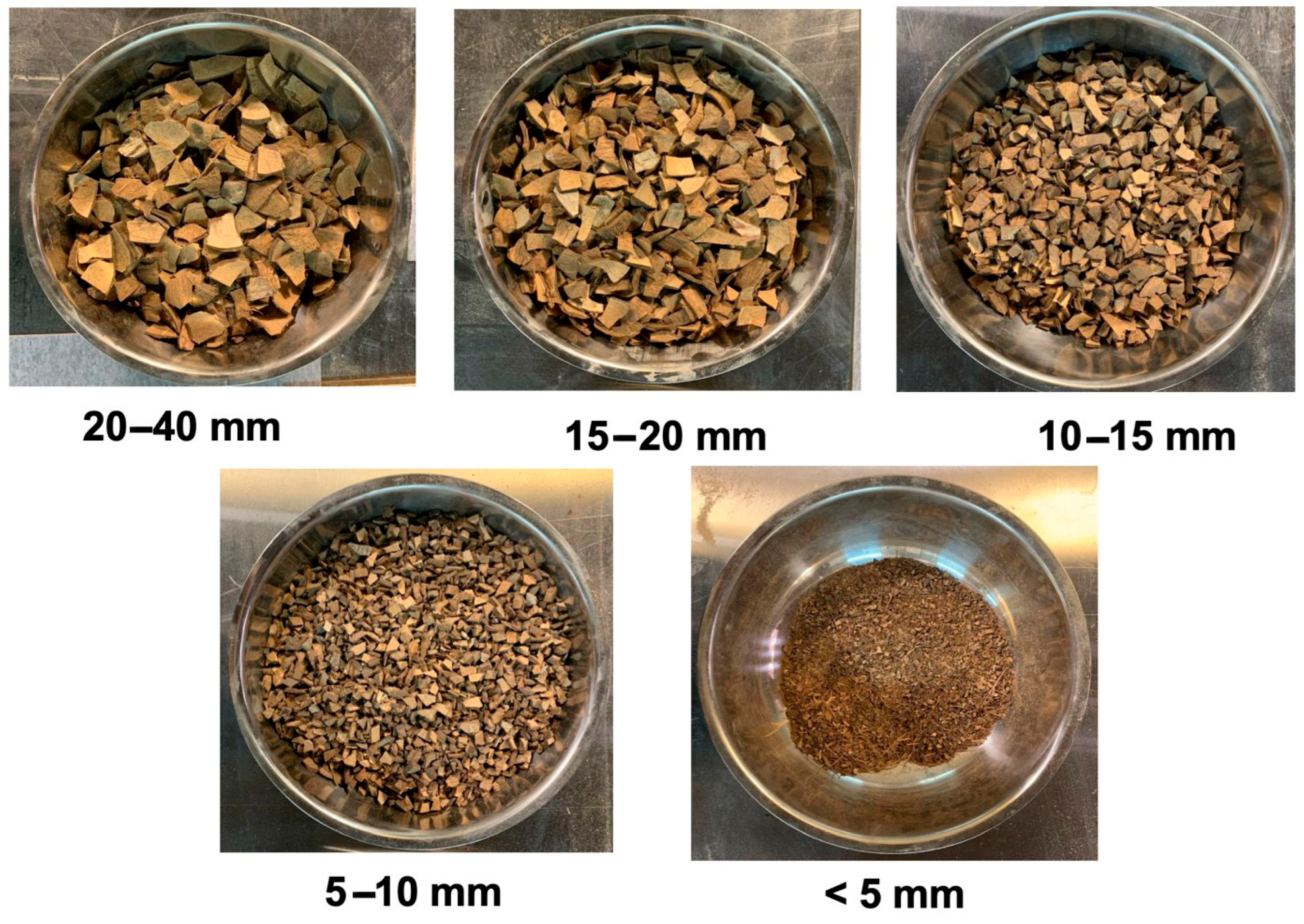

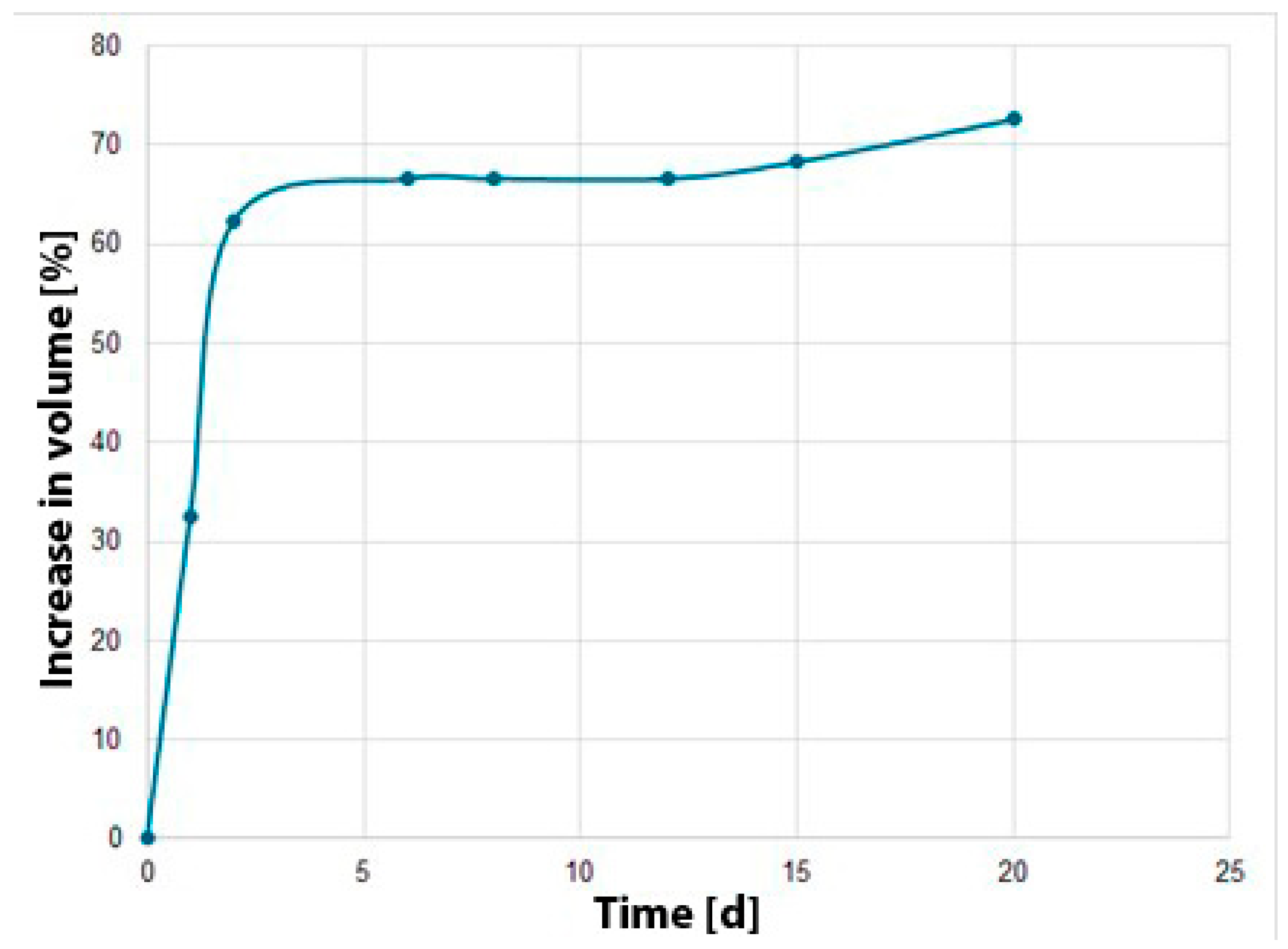

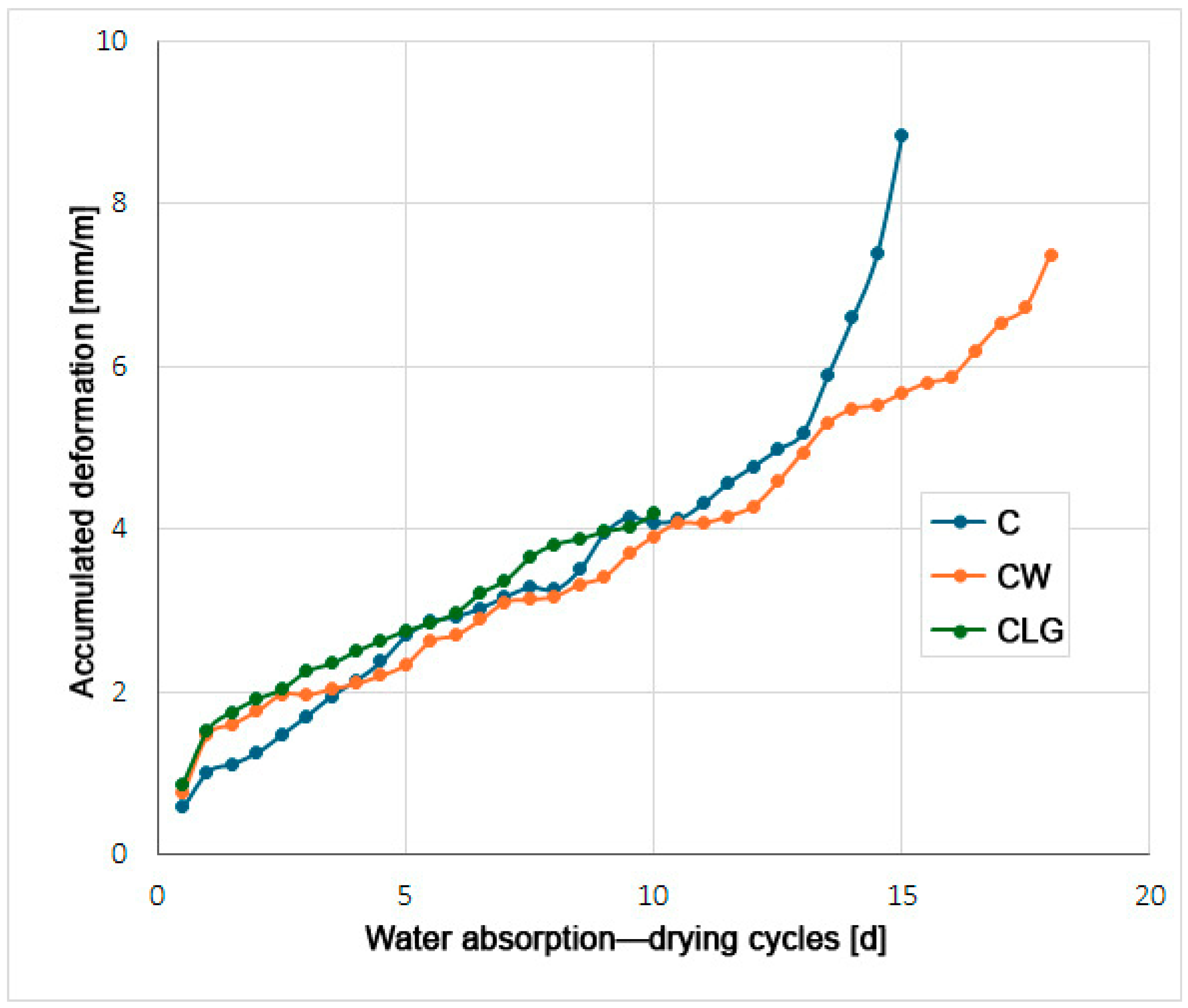
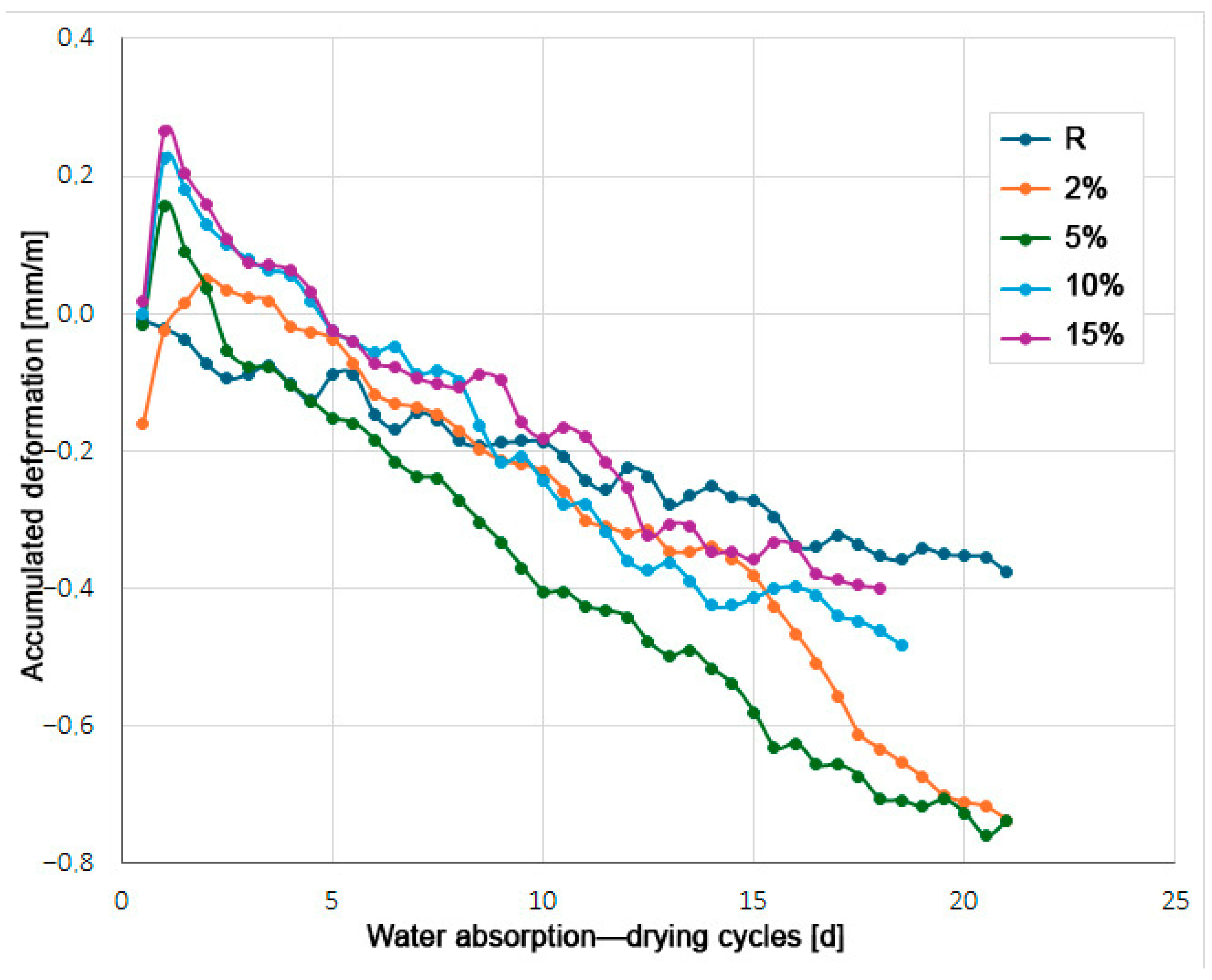
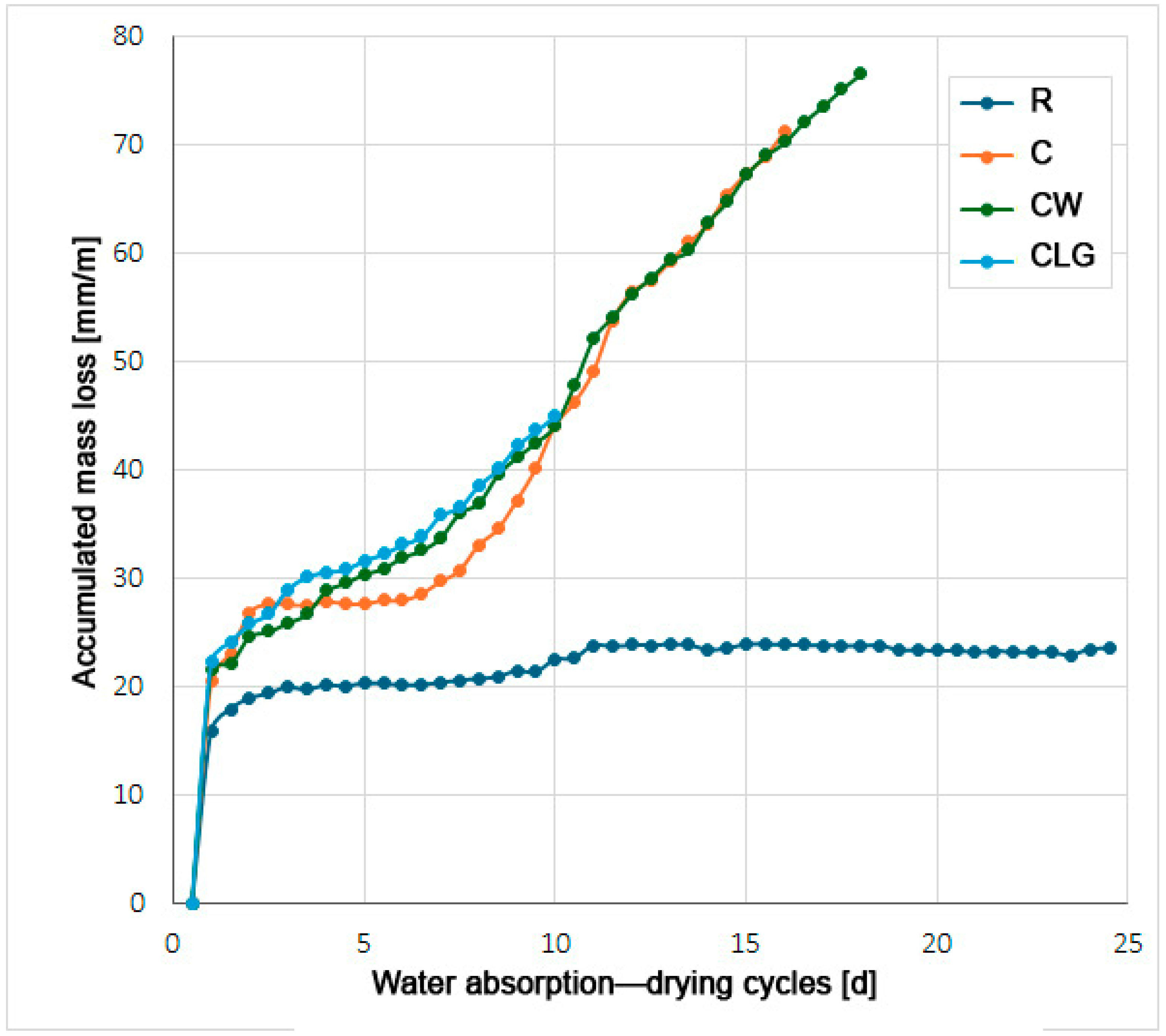
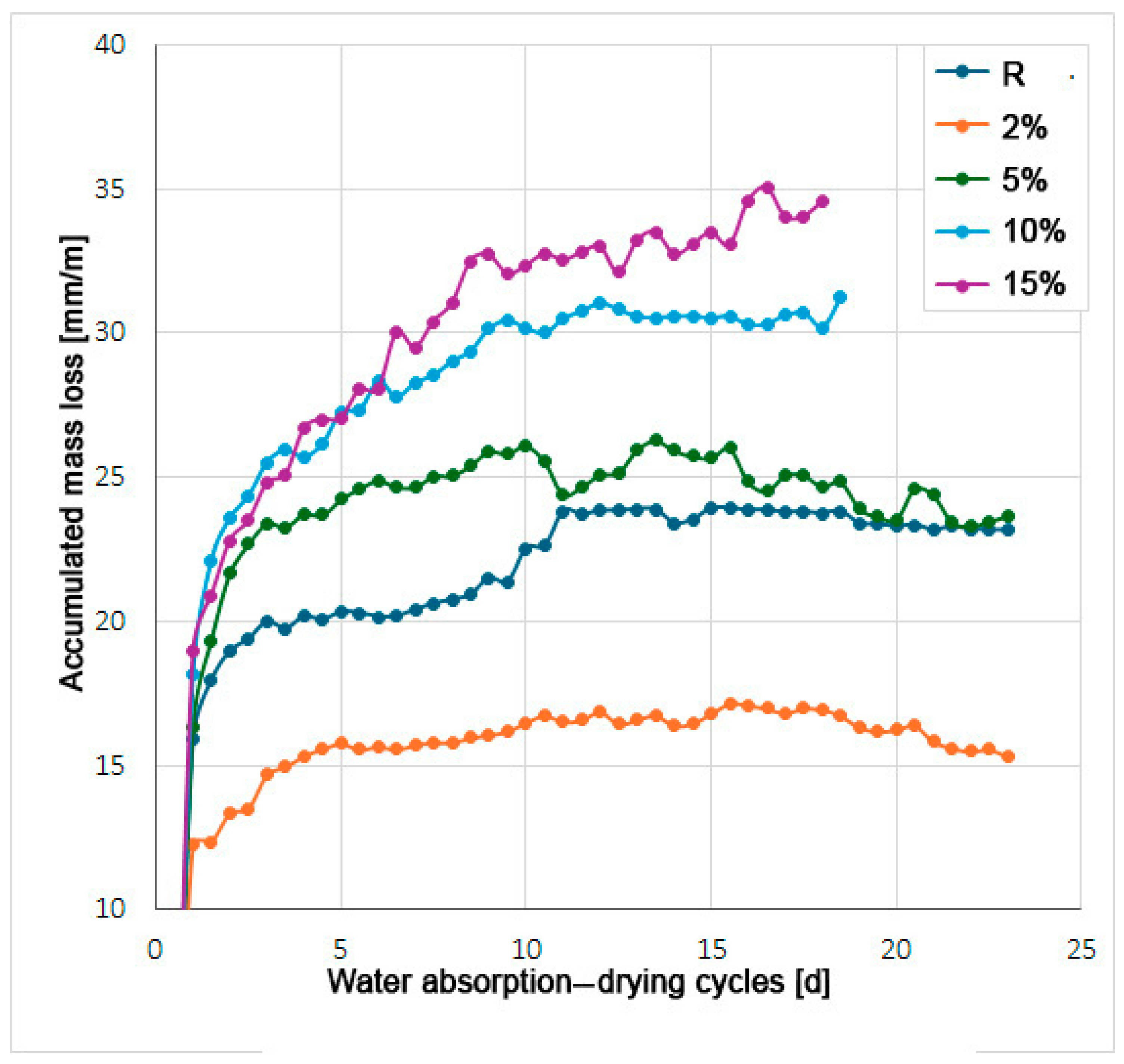
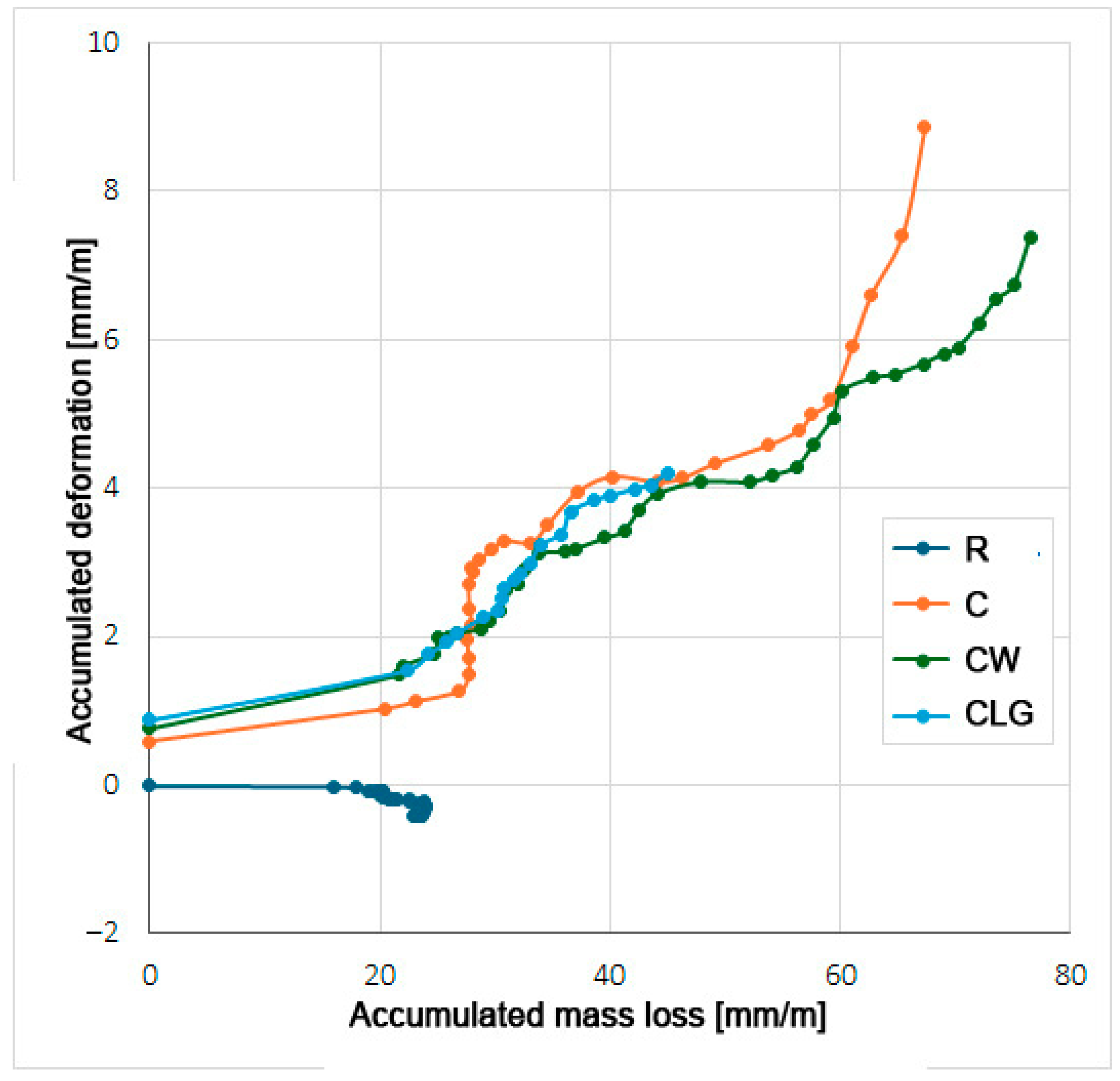
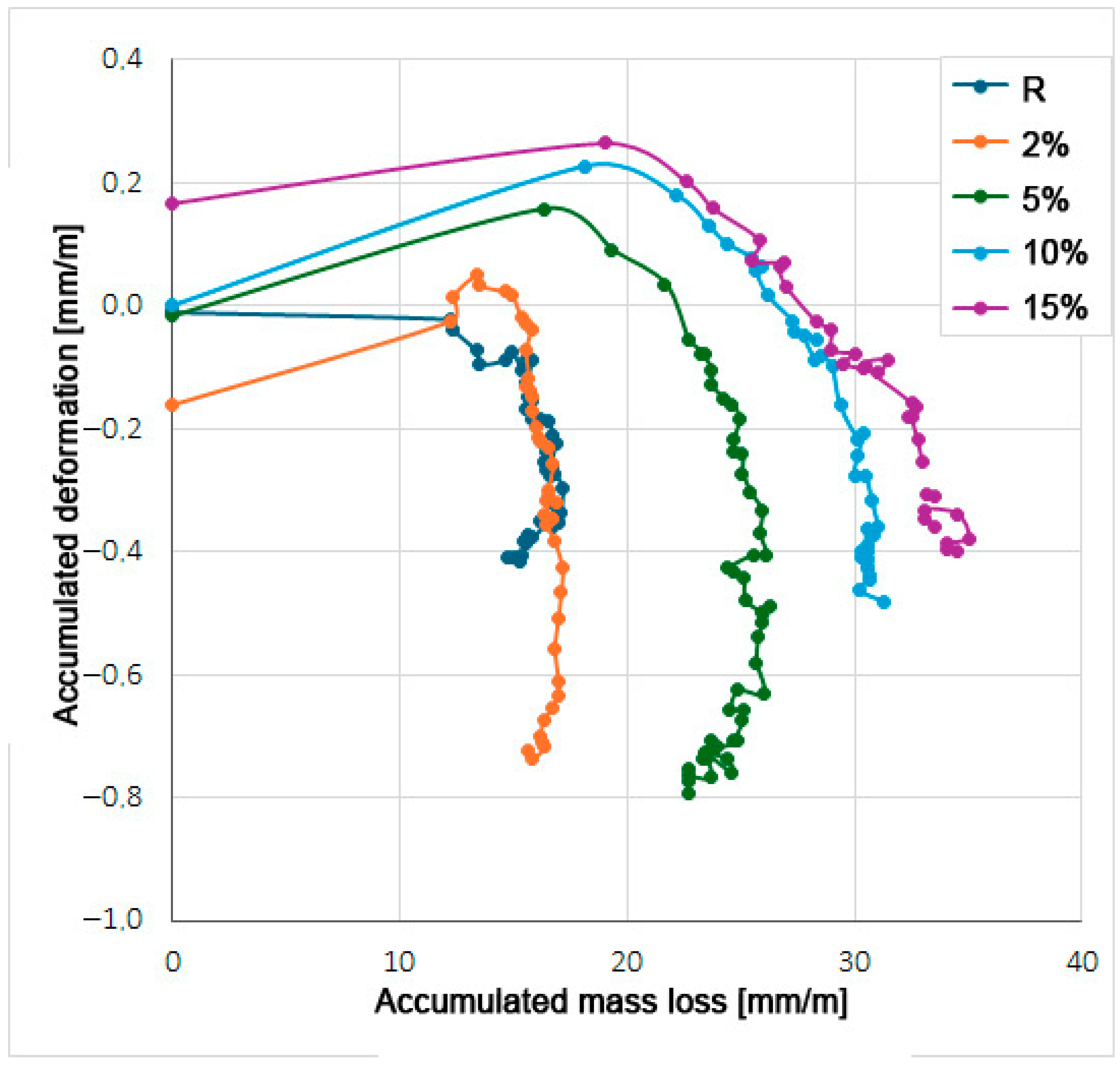
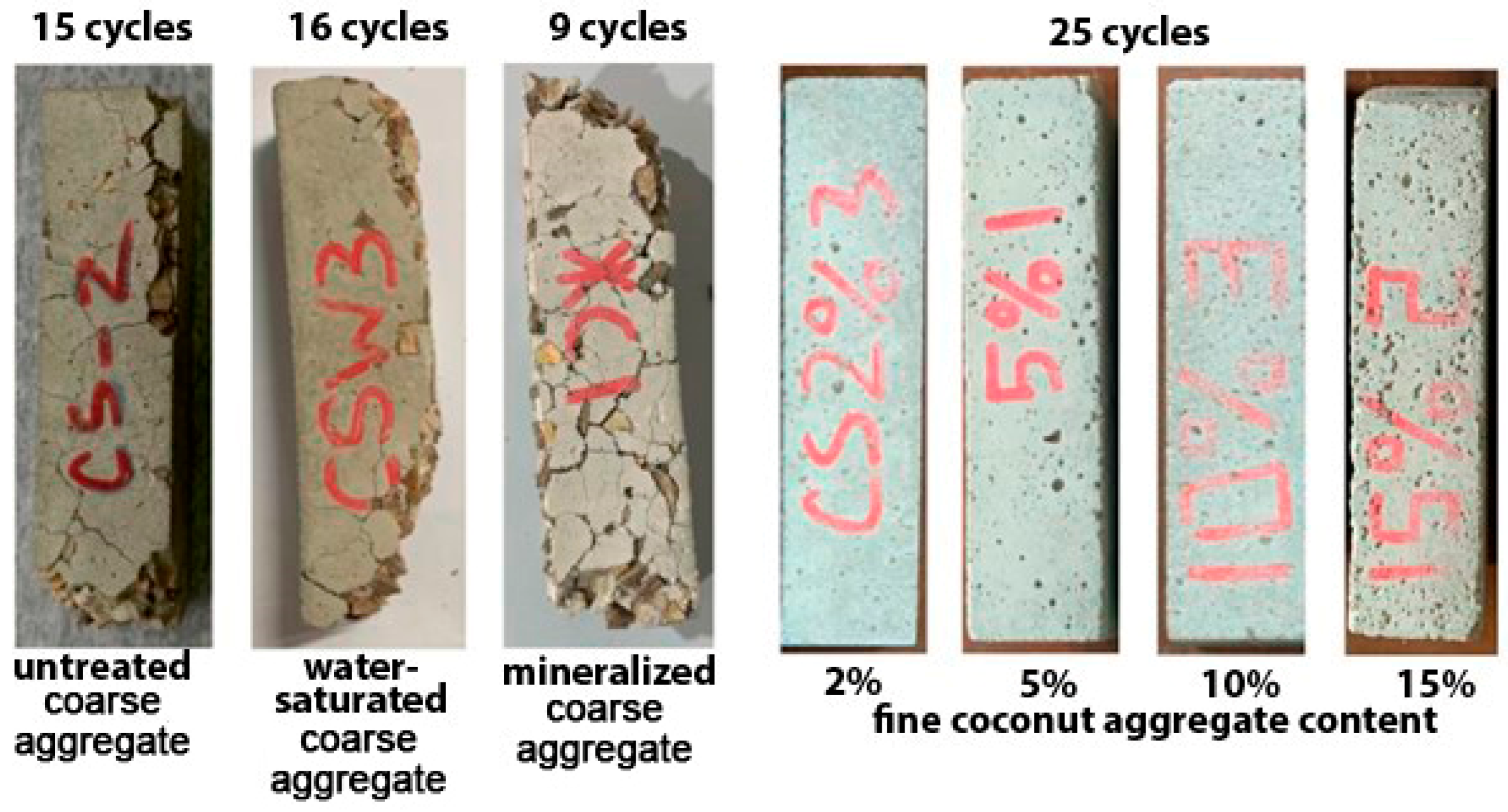




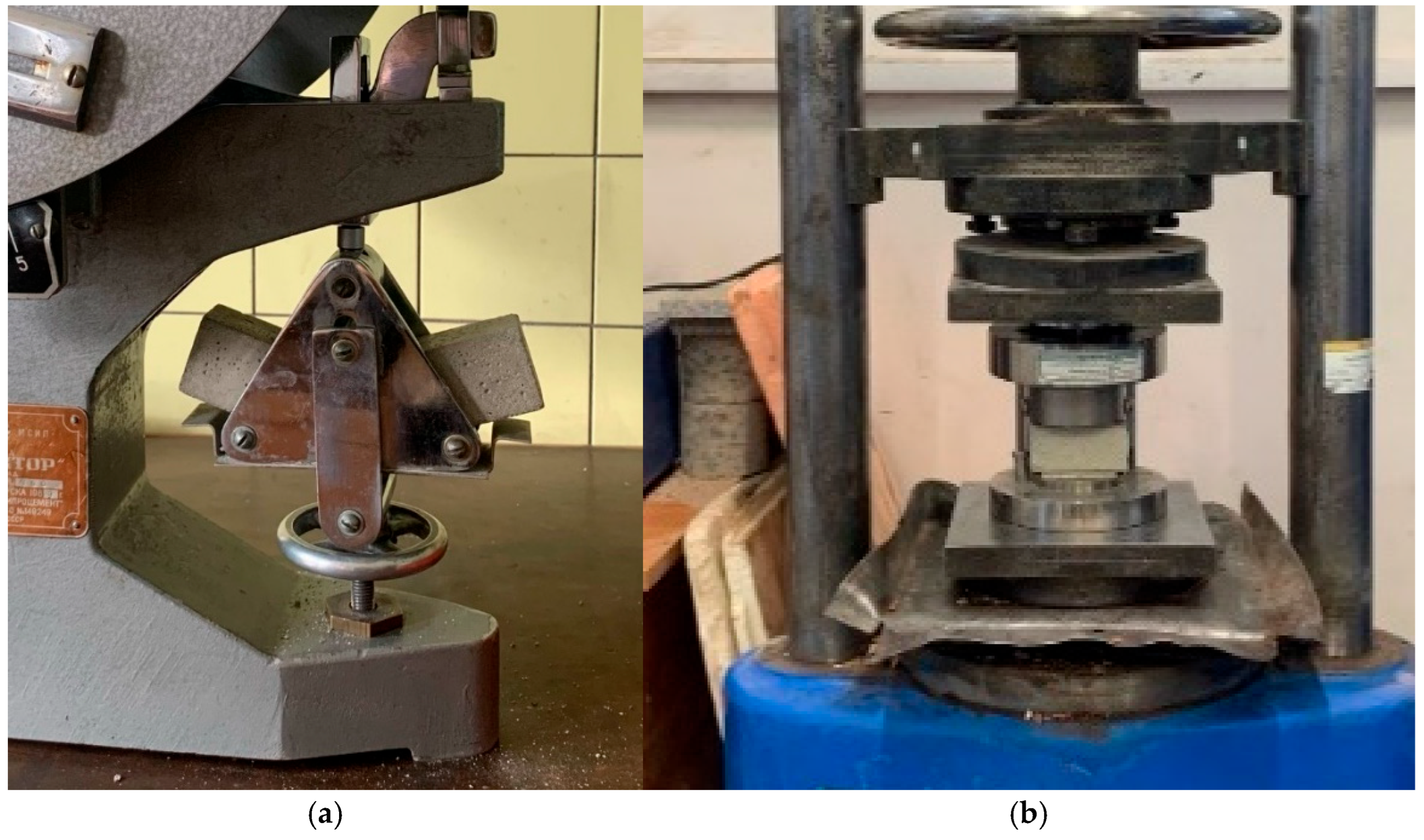
| Fraction Size, mm | % |
|---|---|
| <5 | 4 |
| 5–10 | 29.7 |
| 10–15 | 20.4 |
| 15–20 | 26.3 |
| 20–40 | 19.6 |
| Name of the Indicator | Fraction 5–20 mm | Fine Coconut Aggregate with Aggregate Content in the Mixture, % | |||
|---|---|---|---|---|---|
| 2 | 5 | 10 | 15 | ||
| Volume of coconut aggregate considering expansion during swelling Vc, mL/sample | 79.4 | 4.7 | 11.2 | 22.8 | 34.0 |
| Volume of lost water Vw, mL/sample | 75 | 17 | 26 | 31 | 35 |
| Vc/Vw ratio | 0.94 | 3.62 | 2.32 | 1.36 | 1.03 |
| Coconut Aggregate Content, % | Strength, MPa | |
|---|---|---|
| When Bending | Under Compression | |
| 0 | 7.16 | 54.2 |
| 2 | 6.13 | 45.9 |
| 5 | 6.73 | 49.2 |
| 10 | 4.78 | 40.0 |
| 15 | 4.34 | 33.9 |
| C3S | C2S | C3A | C4AF |
|---|---|---|---|
| 62.91 | 11.36 | 5.36 | 11.76 |
| Material | CaO | SiO2 | Al2O3 | Fe2O3 | MgO | SO3 | K2O + Na2O |
|---|---|---|---|---|---|---|---|
| PCC | 66.33 | 20.57 | 4.49 | 3.87 | 3.22 | 1.26 | 1.18 |
| CSA | 3.55 | 52.55 | 13.74 | 7.65 | 1.60 | 0.57 | 2.82 |
| Mix Name | Characteristics of Mix | Consumption of Components, kg/m3 | |||
|---|---|---|---|---|---|
| Cement | Water | Sand | Coarse Coconut Aggregate | ||
| R | Without coconut aggregate | 488 | 244 | 1464 | 0 |
| C | With coconut aggregate | 488 | 244 | 732 | 293 |
| CW | With water saturated coconut aggregate | 488 | 244 | 732 | 293 |
| CLG | With coconut aggregate treated with lime milk and liquid glass | 488 | 244 | 732 | 293 |
| Mix Name | Consumption of Components, kg/m3 | |||
|---|---|---|---|---|
| Cement | Water | Sand | Fine Coconut Aggregate | |
| R | 488 | 244 | 1464 | 0 |
| 2% | 488 | 244 | 1435 | 12 |
| 5% | 488 | 244 | 1391 | 29 |
| 10% | 488 | 244 | 1317 | 59 |
| 15% | 488 | 244 | 1244 | 88 |
Disclaimer/Publisher’s Note: The statements, opinions and data contained in all publications are solely those of the individual author(s) and contributor(s) and not of MDPI and/or the editor(s). MDPI and/or the editor(s) disclaim responsibility for any injury to people or property resulting from any ideas, methods, instructions or products referred to in the content. |
© 2025 by the authors. Licensee MDPI, Basel, Switzerland. This article is an open access article distributed under the terms and conditions of the Creative Commons Attribution (CC BY) license (https://creativecommons.org/licenses/by/4.0/).
Share and Cite
Barabanshchikov, Y.; Usanova, K.; Koneva, A. Performance of Cement Composites with Partial Replacement with Organic Aggregate from Waste Coconut Shell. Recycling 2025, 10, 51. https://doi.org/10.3390/recycling10020051
Barabanshchikov Y, Usanova K, Koneva A. Performance of Cement Composites with Partial Replacement with Organic Aggregate from Waste Coconut Shell. Recycling. 2025; 10(2):51. https://doi.org/10.3390/recycling10020051
Chicago/Turabian StyleBarabanshchikov, Yurii, Kseniia Usanova, and Alexandra Koneva. 2025. "Performance of Cement Composites with Partial Replacement with Organic Aggregate from Waste Coconut Shell" Recycling 10, no. 2: 51. https://doi.org/10.3390/recycling10020051
APA StyleBarabanshchikov, Y., Usanova, K., & Koneva, A. (2025). Performance of Cement Composites with Partial Replacement with Organic Aggregate from Waste Coconut Shell. Recycling, 10(2), 51. https://doi.org/10.3390/recycling10020051





